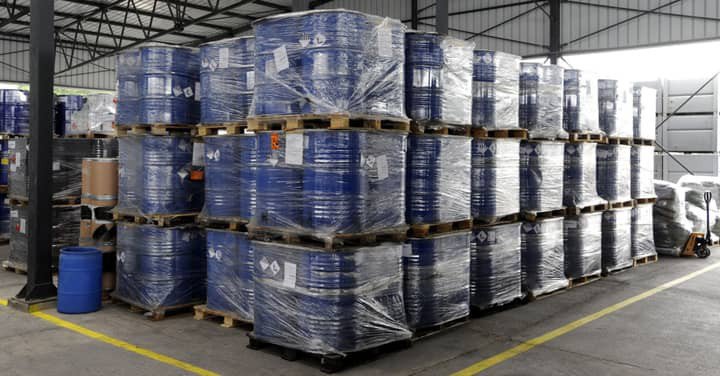
Shipping goods across the ocean is almost always a complicated undertaking. When shipping hazmat materials, the process becomes all the more challenging and complex. While it's understandable that hazardous material shipping would entail plenty of hoops to jump through, these obstacles can nonetheless create nightmares for shippers.
There are several things hazmat shippers must consider to ensure the safe and successful transport of dangerous goods. This complete guide to hazmat shipping covers everything you need to know about shipping hazmat materials, from how to interpret hazmat codes for shipping to the essential steps to take when preparing a hazmat shipment.
The Basic Rules of Shipping Hazardous Materials
If you are shipping goods that the Department of Transportation (DOT) has classified as hazardous, there are numerous rules and regulations to follow. Requirements regarding the shipping papers that need to accompany your shipment, how your shipment is marked and labeled, and how your shipment is prepared and packaged are a few. Later sections of this guide cover the specifics of these various rules and regulations. For now, though, understand that shippers have quite a few responsibilities to attend to if they plan to ship hazardous materials.
What Products Are Classified as Hazmat?
What is considered hazardous material for shipping? This is the first question to be addressed when covering what shippers need to know about hazmat shipping.
Hazardous materials are any good that the DOT deems to pose an unreasonable risk to health, safety, or property. The DOT further classifies dangerous goods into nine different classes:
-
Class 1: Explosives – Defined as products prone to explode under certain conditions, including gunpowder, fireworks, and ammunition.
-
Class 2: Gases – Defined as products that contain either toxic, flammable, or explosive gases and include products such as aerosols, lighters, and fire extinguishers.
-
Class 3: Flammable Liquids – Defined as liquids that will ignite when exposed to an open flame and includes products such as gasoline, paint thinner, and nail polish.
-
Class 4: Flammable Solids – Defined as solid substances that will ignite when exposed to an open flame and includes products such as matches, sulfur, and coal.
-
Class 5: Oxidizing Substances – Defined as chemicals prone to causing combustion due to the large amounts of oxygen they yield in reactions. These products include chlorine, ammonium nitrate fertilizers, and bleach.
-
Class 6: Toxic/Infectious Substances – Defined as substances that can cause harm, serious injury, or death when inhaled, contacted, or swallowed and includes products such as biomedical waste, pesticides, and arsenic.
-
Class 7: Radioactive Material – Defined as any material that spontaneously gives off ionizing radiation and includes products such as radioactive medicines, X-ray machines, and depleted uranium.
-
Class 8: Corrosives – Defined as a corrosive material that causes damage when it contacts property or human skin and includes products such as sulfuric acid, hydrochloric acid, and paint stripper.
-
Class 9: Miscellaneous Hazardous Materials – Defined as products that don't fit in any of the other classes but are still hazardous when shipped and include products such as dry ice, lithium-ion batteries, and vehicles.
As you can see, there are quite a few different products that the DOT classifies as hazardous, many of which might seem like something other than obvious entries to the list. This means that many more shippers than you might realize are required to comply with hazmat regulations.
Dangerous Goods Regulating Agencies
In the United States, the Department of Transportation is responsible for enforcing all transportation laws and regulations, including regulations regarding the shipment of hazardous materials. If you ship goods within the United States, you must comply with the DOT's regulations outlined in the Code of Federal Regulations (CFR) 49 (See Subtitle B, Chapter 1).
When shipping hazmat materials internationally, you must adhere to regulations set by two agencies within the United Nations. For hazardous goods that are transported internationally by air, the International Civil Aviation Organization's (ICAO) Technical Instructions for the Safe Transport of Dangerous Goods by Air provides the regulations that shippers must follow. For hazardous goods shipped internationally by sea, shippers must adhere to the rules set forth by the International Maritime Organization (IMO).
What Are the Shipper's Responsibilities?
The exact responsibilities that shippers will have when shipping hazardous goods ultimately depend on the mode of transport, the type of materials shipped, and where they are destined. However, some general responsibilities apply when a shipper is shipping products classified as hazardous. These responsibilities include:
-
Determining whether the products they are shipping are classified as a hazardous material
-
Providing a proper shipping name
-
Determining the class and division of the hazardous goods
-
Providing a proper identification name
-
Placing a hazard warning label on the shipment
-
Properly marking the shipment as hazardous
-
Providing hazmat training to any employee who handles hazardous materials
-
Providing appropriate shipping papers
-
Providing emergency response information
-
Earning IATA Certification for Hazardous Material Shipping
-
Properly blocking and bracing the shipment
-
Providing a security plan
-
Engaging in incident reporting
Though understandably necessary, this long list of hazmat shipping responsibilities makes the process a real headache for shippers. Thankfully, freight management services such as freightmango can reduce the burden of hazmat shippers and ensure that their freight gets delivered without issue.
What is Hazmat Employees Training?
One of the responsibilities of hazmat shippers is to provide hazmat training to any employee handling hazardous materials. This training should extend to include any employee who loads, unloads, or handles hazardous materials, prepares hazardous materials for transportation, and operates a vehicle used to transport hazardous materials. These "hazmat employees" must complete hazmat training, including:
-
General awareness/familiarization training
-
Function-specific training
-
Safety training
-
Security awareness training
-
In-depth security training (if a security plan is required)
-
Driver training (for employees operating a motor vehicle used to transport hazardous materials)
Hazardous Materials Shipment Preparation
Employees must prepare all hazardous shipments according to the exact regulations that shippers must follow. These regulations can vary based on how the materials are shipped and the origin and destination points, respectively. Generally speaking, though, here are the steps for preparing hazardous materials for shipment.
Step 1: Identifying the Hazardous Material
Preparing hazardous materials for shipment starts by identifying the exact class and subclass under which your materials fall. You will use this information to identify and comply with other shipment preparation requirements.
Step 2: Preparing the Materials for Shipment
All hazardous materials must be properly packed, marked, and labeled, following appropriate hazmat shipping regulations. In the next section, we'll explain how hazmat shipments should be marked and labeled.
Step 3: Completing Required Documents
Before you can ship hazardous materials, you must complete a Preliminary Dangerous Goods Declaration. This document will contain the name of the commodity being shipped and its Class Number.
Step 4: Retaining Shipping Records
All shipping records must be retained for hazmat shipments for two years after the initial carrier accepts the shipment. For hazardous waste shipments, you must retain shipping records for three years.
Marking and Labeling of Hazardous Materials
For shipments within the United States, you must mark all packages containing hazardous materials in accordance with Title 49 Code of Federal Regulations (49 CFR) requirements. These markings should include the proper shipping name and identification number of the hazardous materials the package contains and must be durable, written in English, and not obscured by any other markings or labels. Additional information may be required depending on the exact materials being shipped.
Packages containing hazardous materials must also be properly labeled. The most commonly used label for hazardous shipments is a diamond-shaped label that displays the hazard class and division of the shipped materials. This label must contrast with the color of the packaging so that it is visible.
For hazardous materials that present more than a single hazard (for example, a material that is both toxic and flammable), you might be required to include a subsidiary label for each additional hazard. These subsidiary labels must be displayed within six inches of the primary hazard label.
However, in some cases, packages containing hazardous materials will not require labeling. Examples include:
-
Packages shipped in a Limited Quantity
-
Packages shipped under a DOT special permit
-
Packages prepared under 49 CFR 173.13
How freightmango Helps With Hazardous Materials Shipping
freightmango provides a range of best-in-class ocean freight shipping services designed to help shippers reduce their administrative burden and create an efficient, cost-effective supply chain. One of the many solutions that freightmango provides is assisting shippers with hazardous materials. By leveraging our deep experience with hazmat shipping and our industry-leading network of carriers, we can ensure that your hazardous materials safely arrive at their destination with no issues along the way.
There's a lot that can go wrong when shipping hazardous goods. Contact us today to learn how freightmango can ensure your next hazardous materials shipment goes off without a hitch!





 Get instant quote
and compare offers in real time
Get instant quote
and compare offers in real time